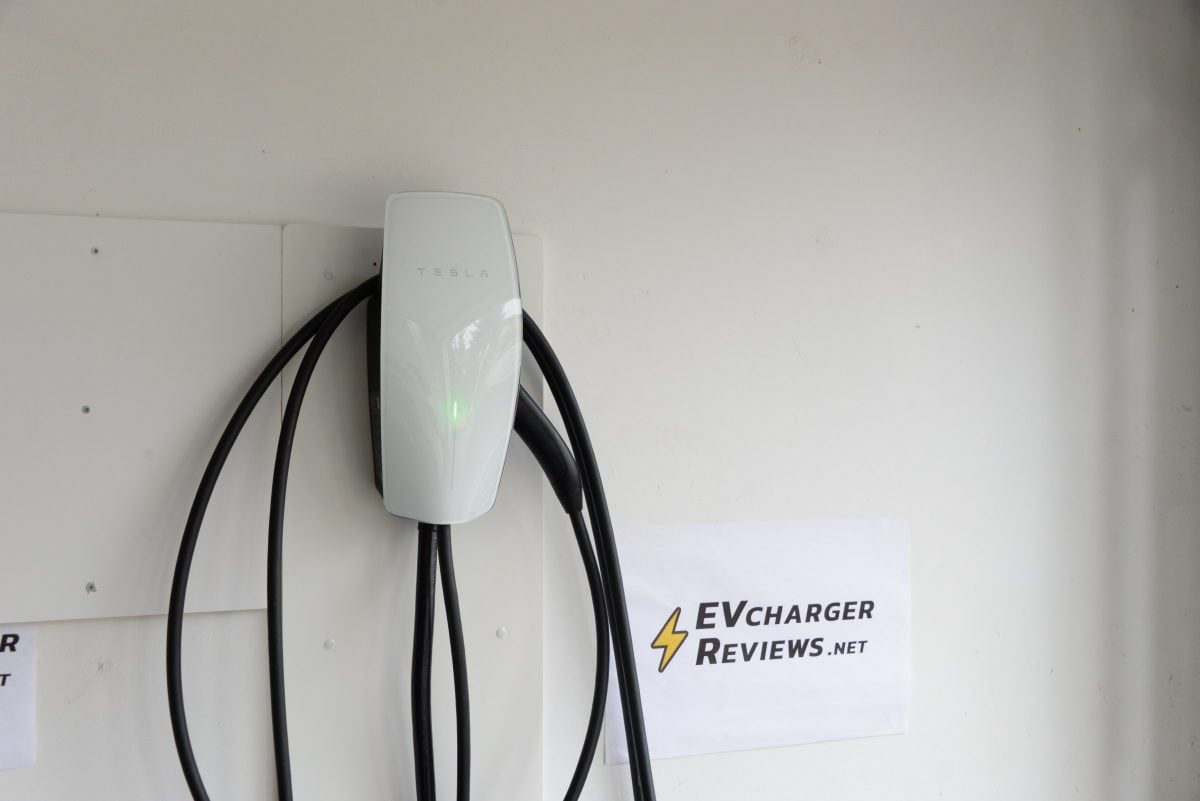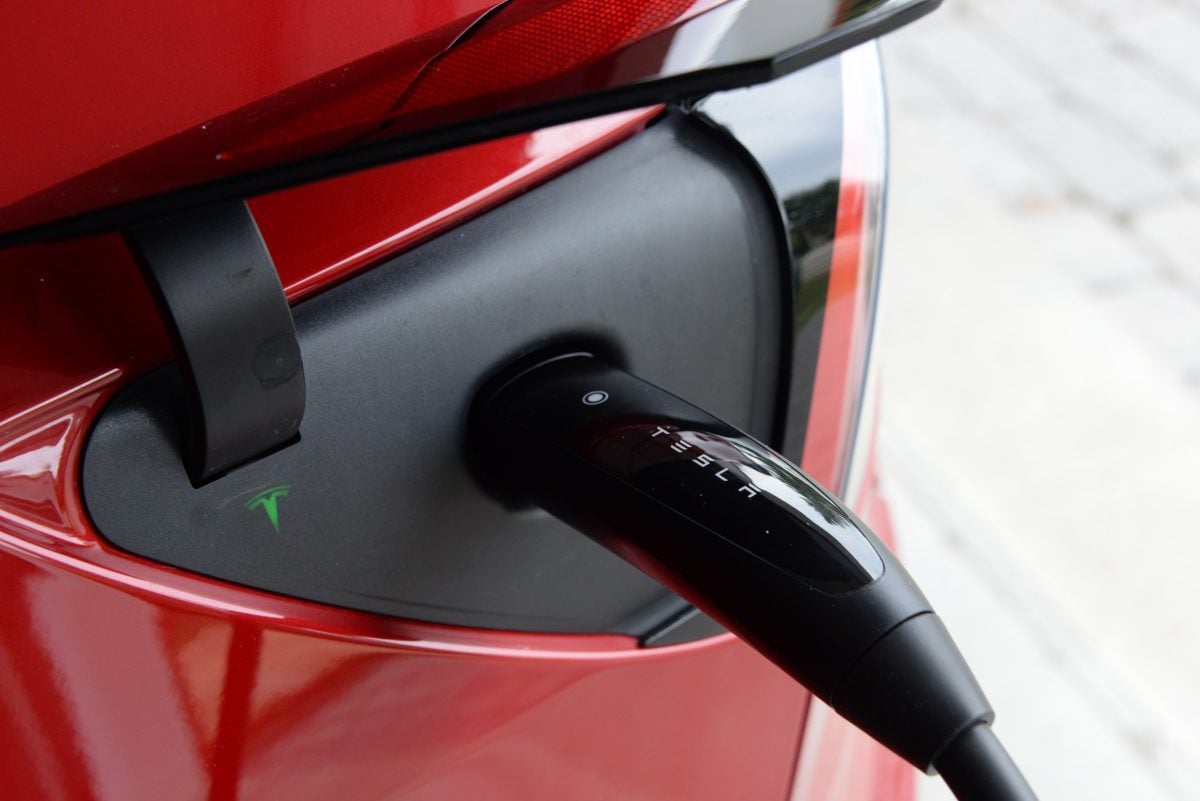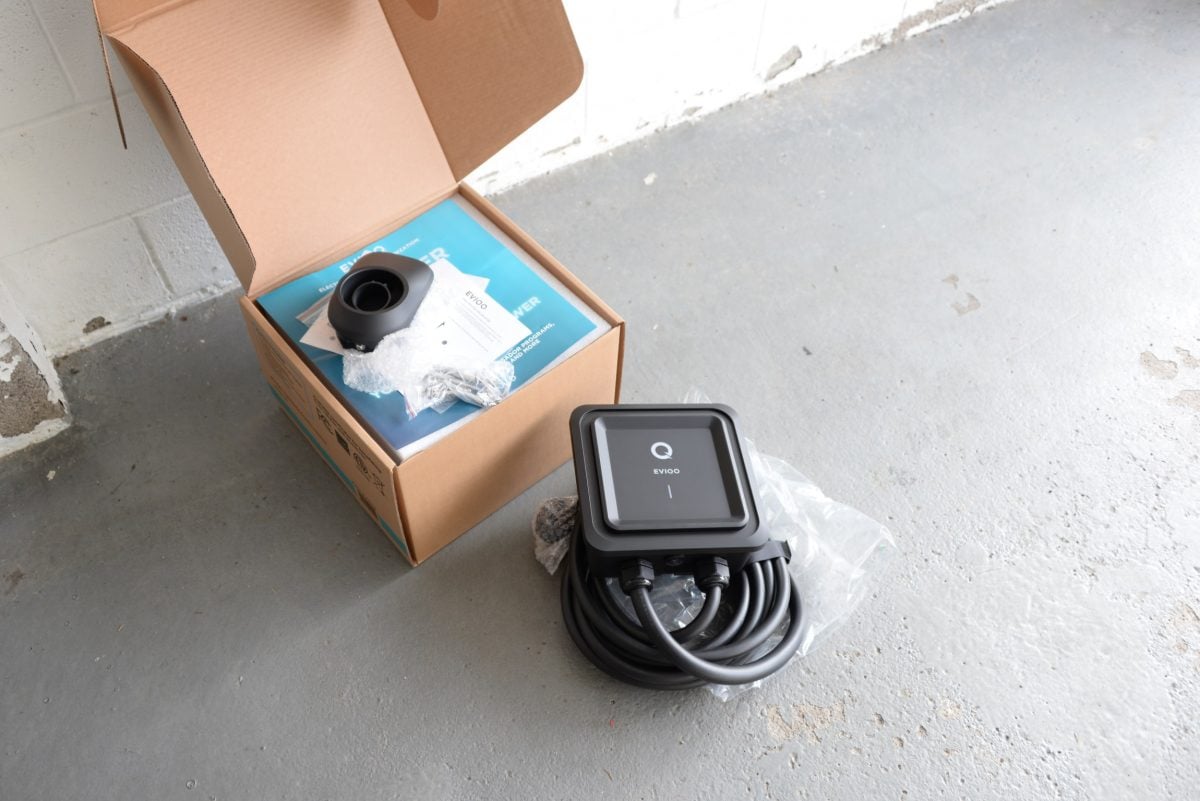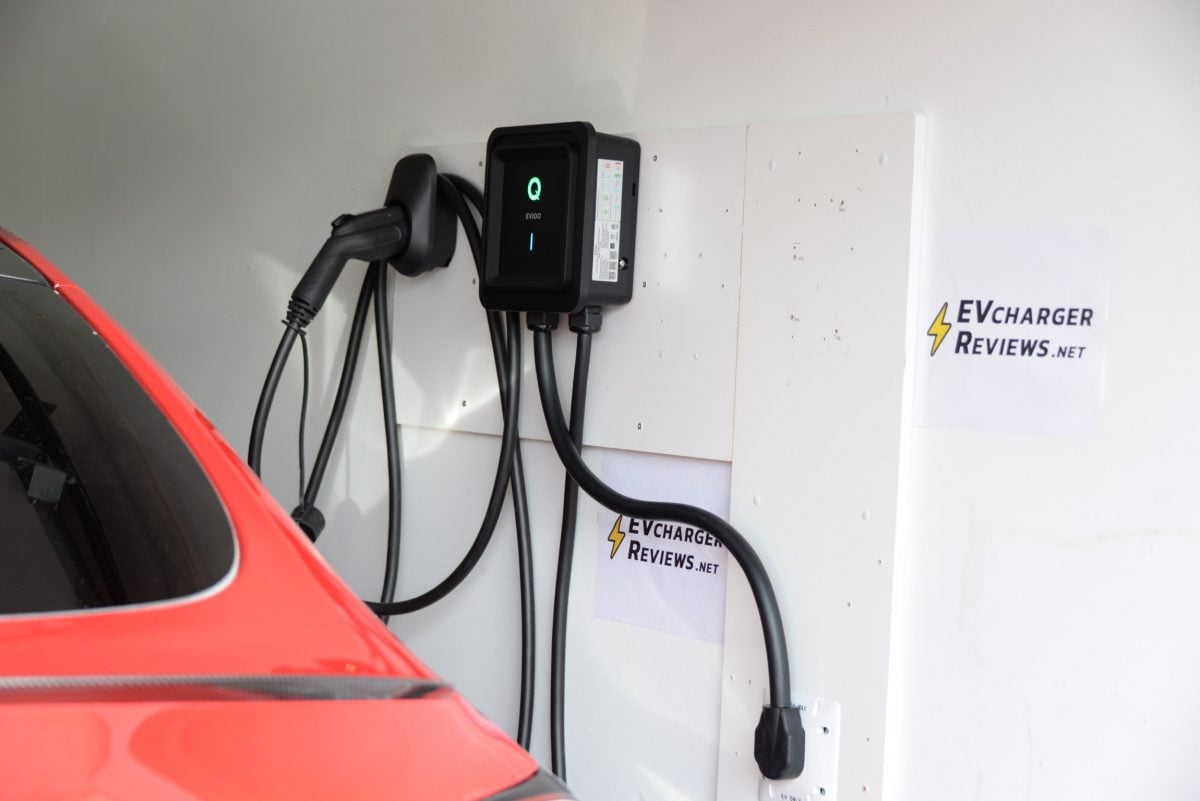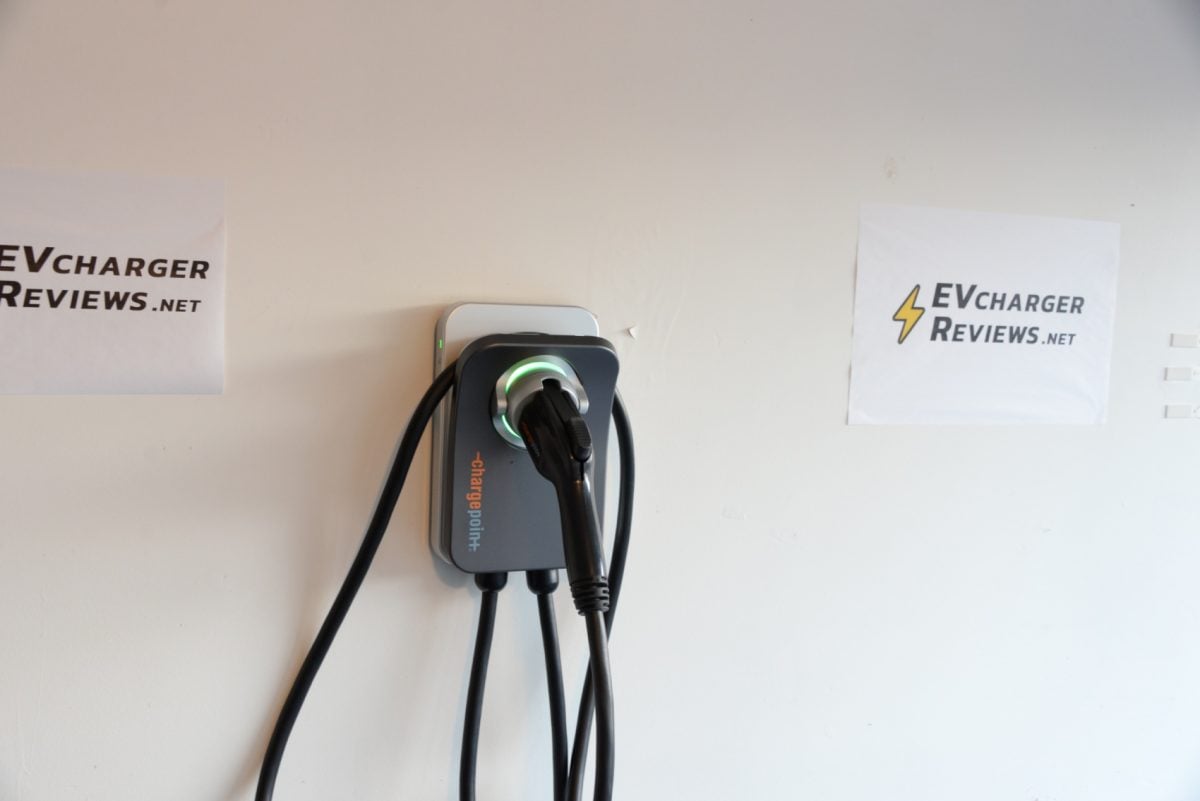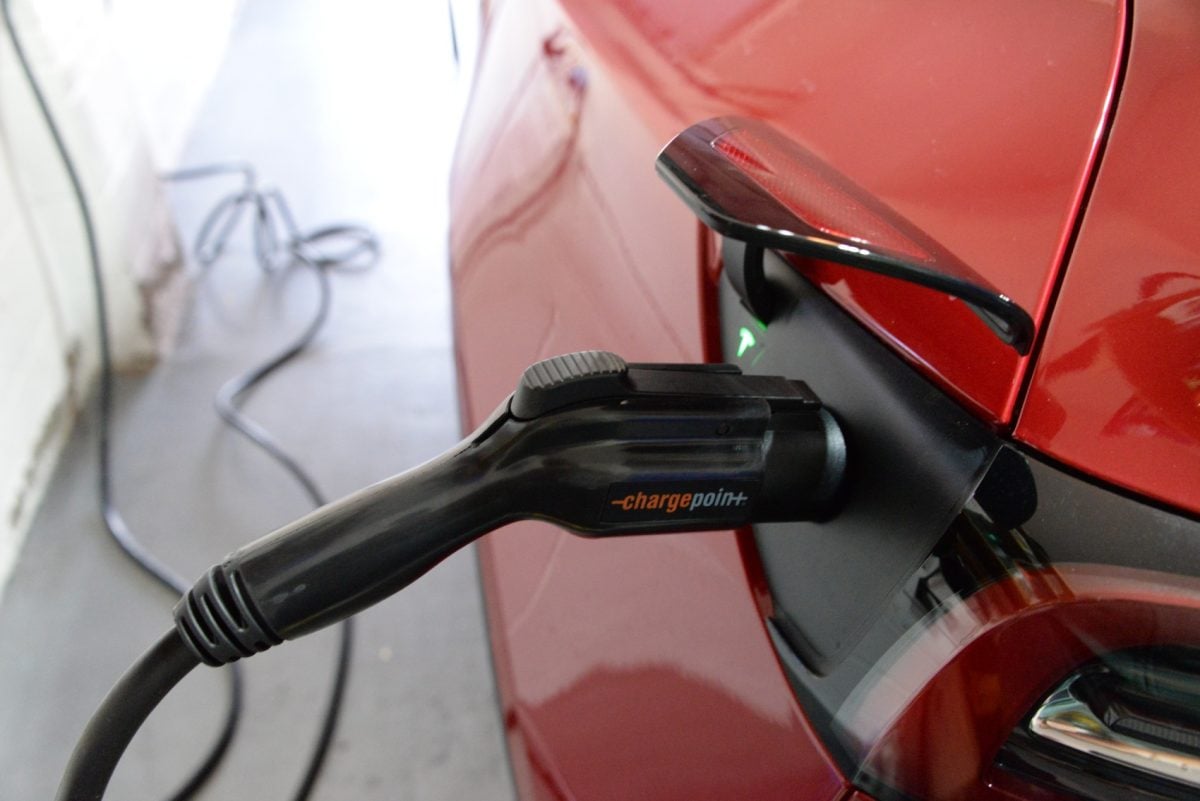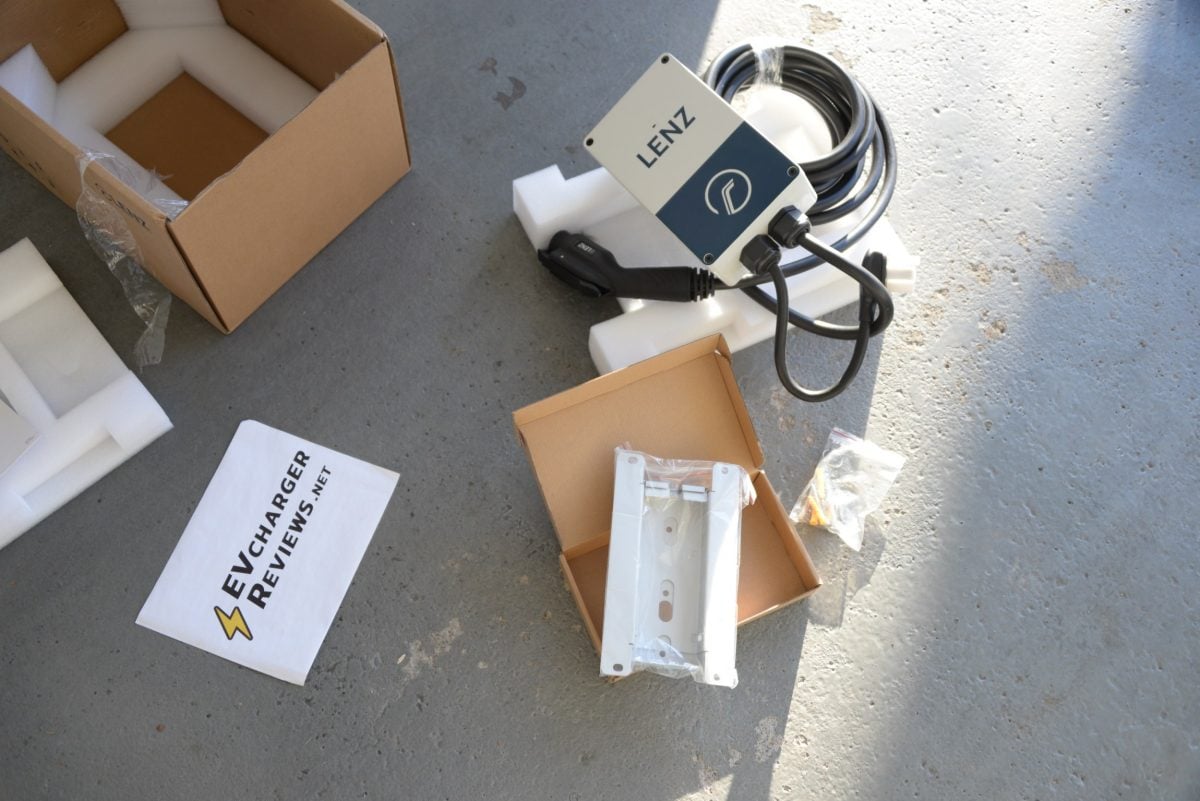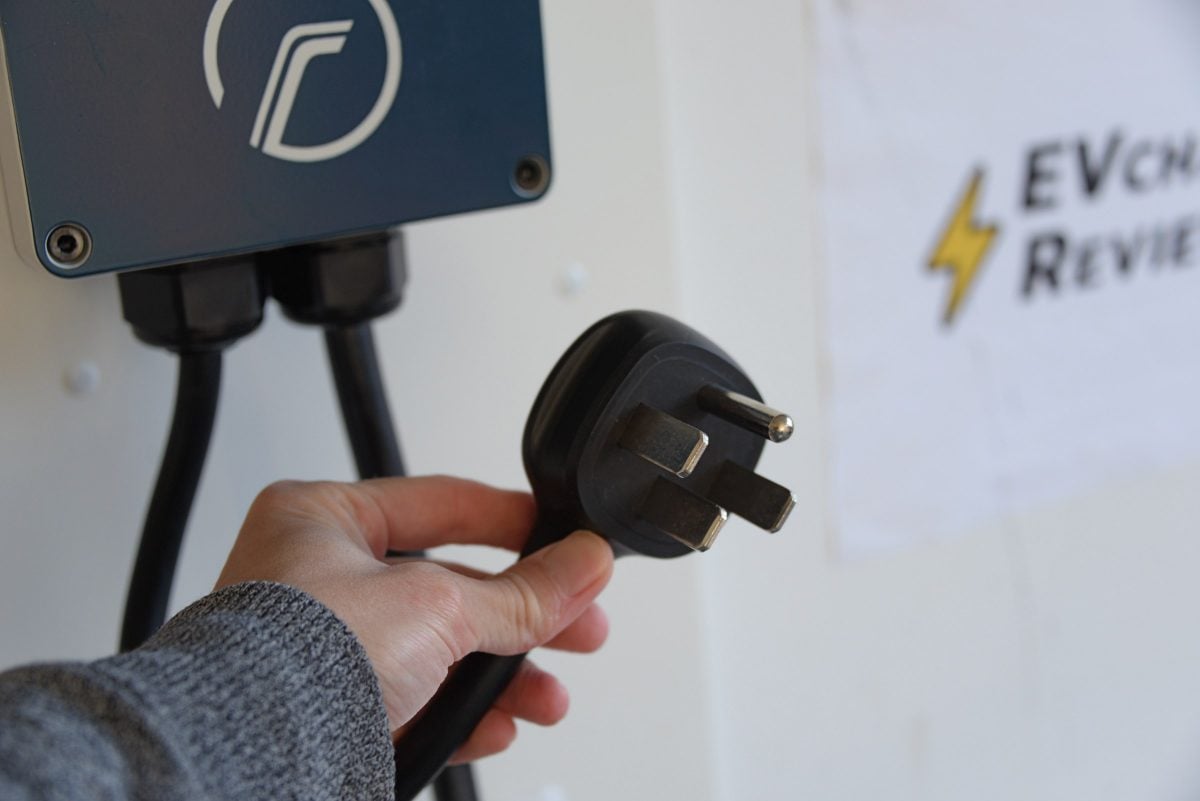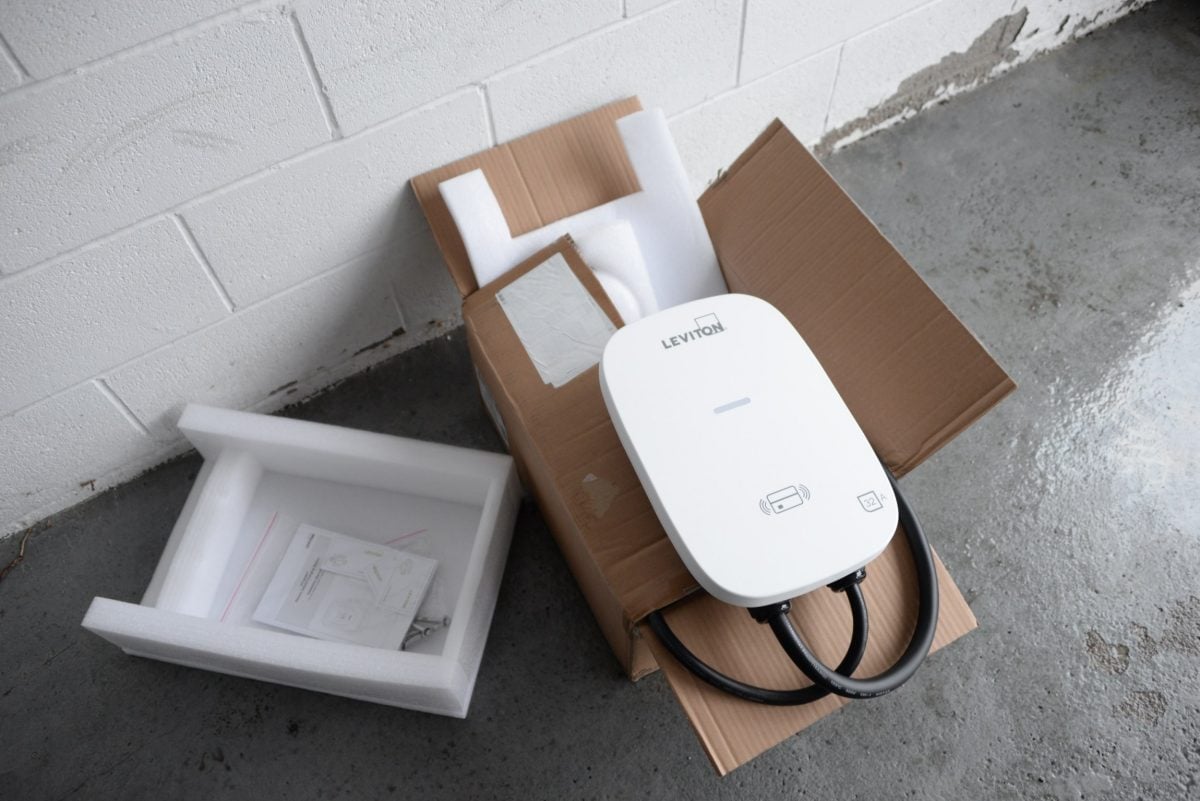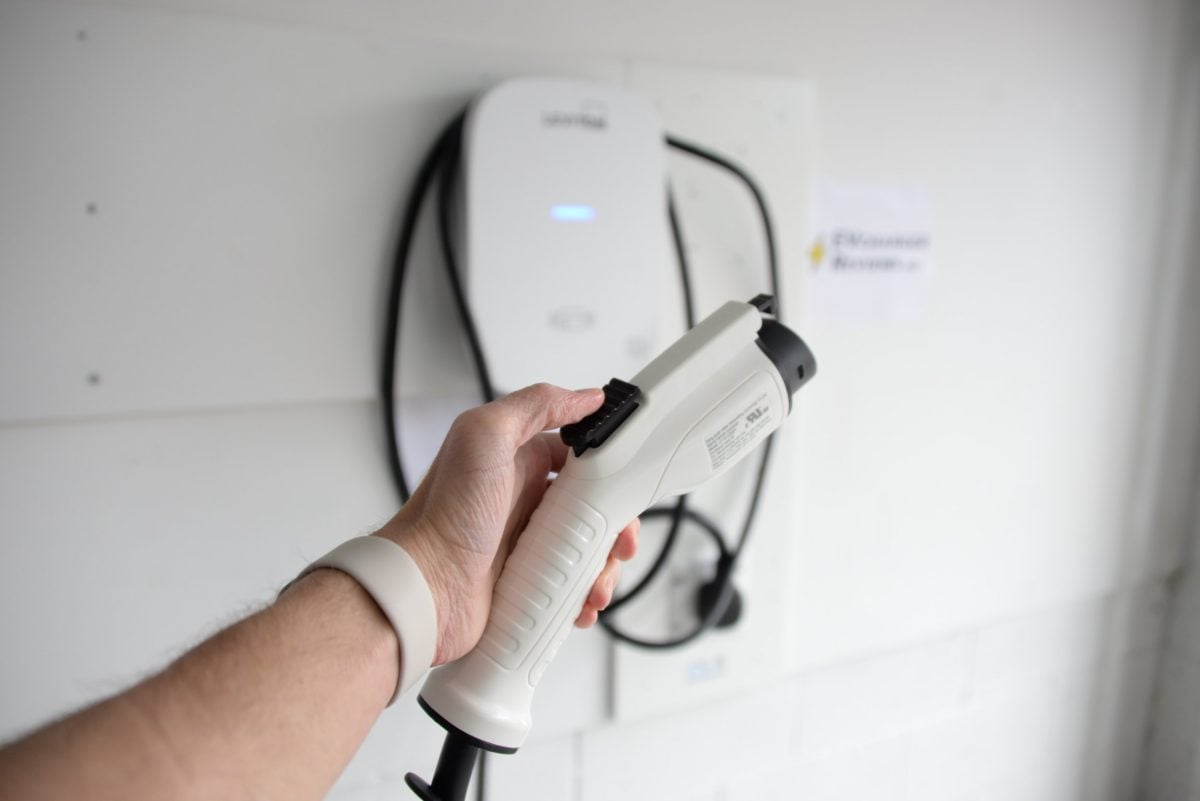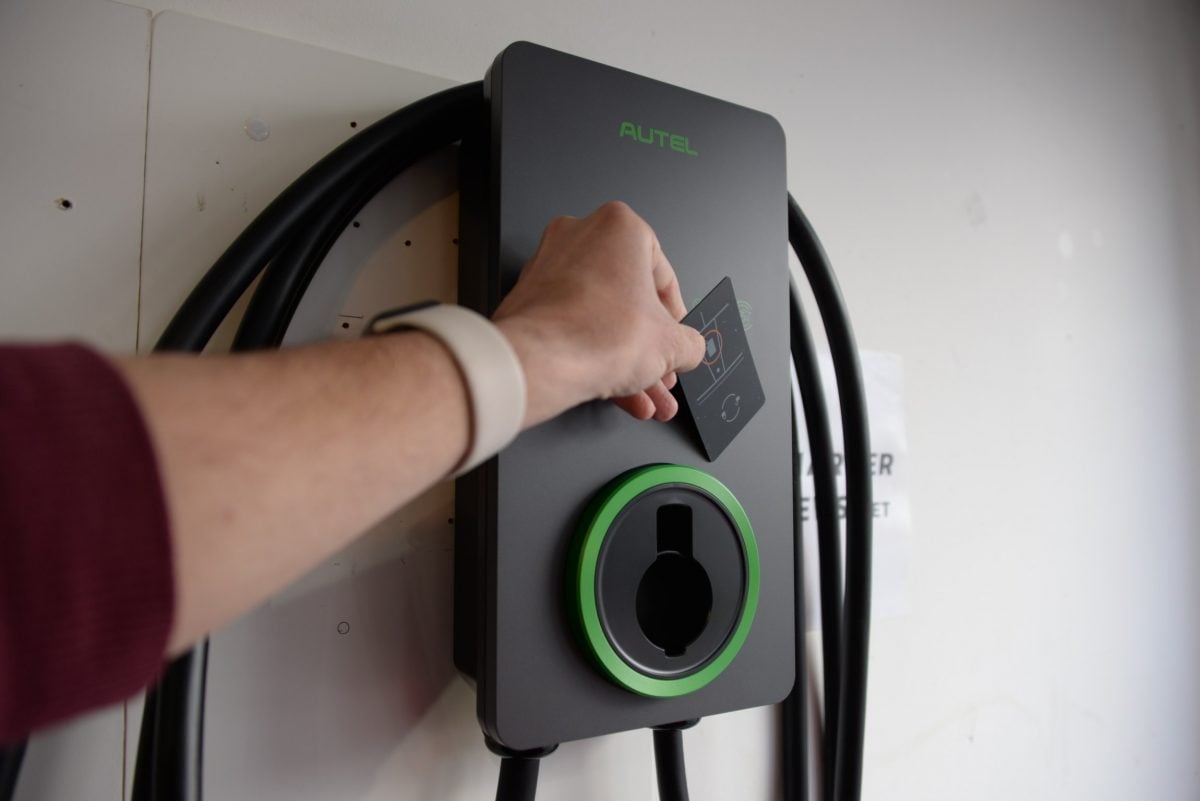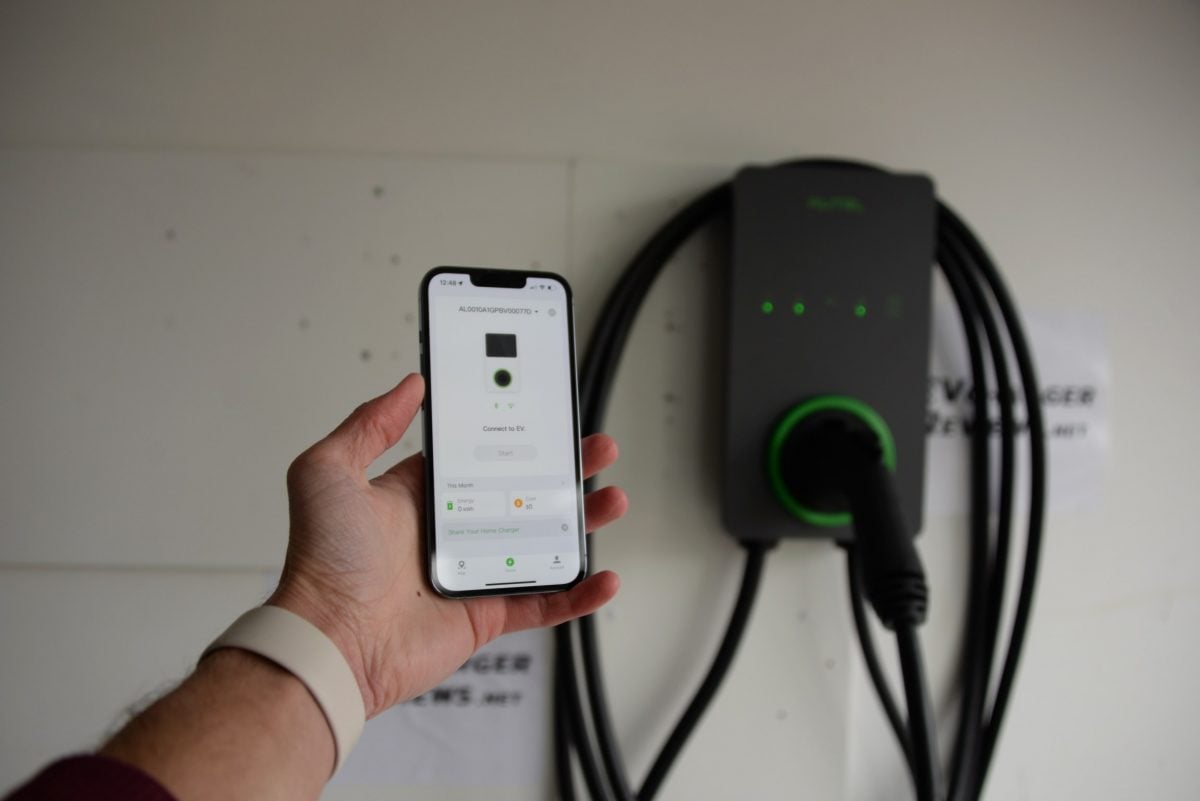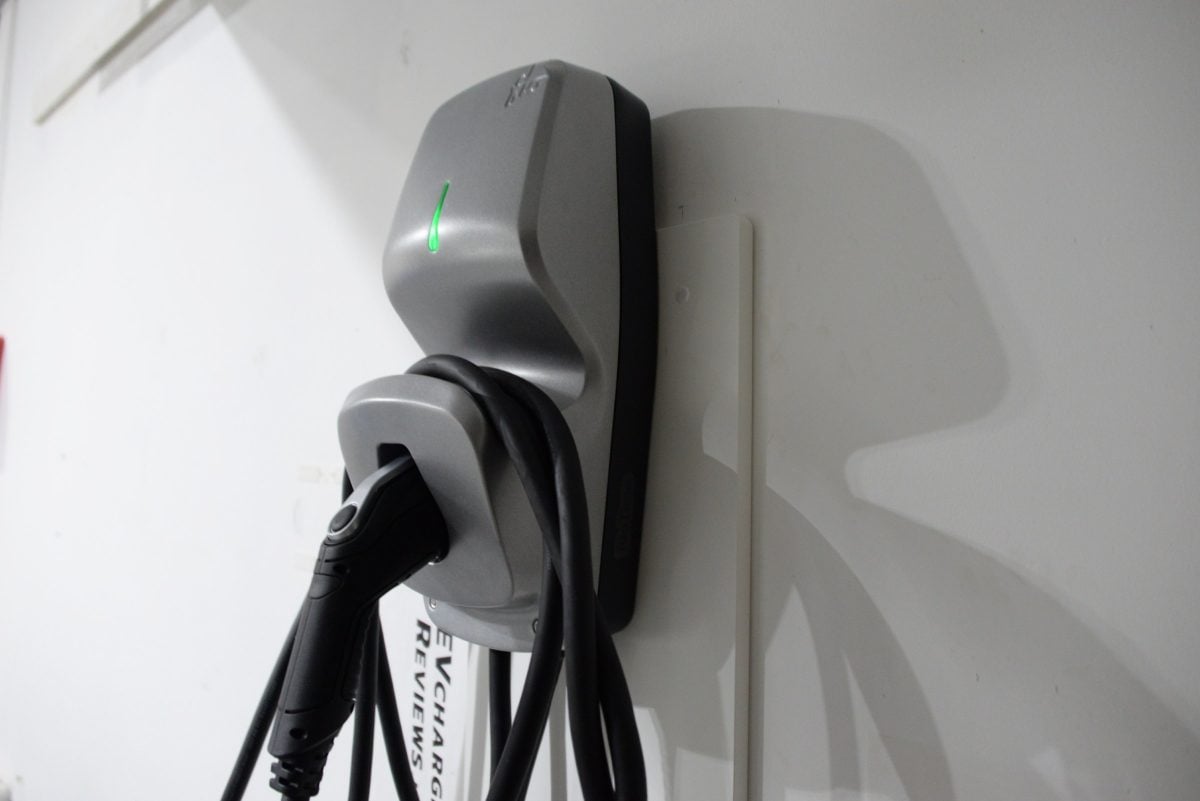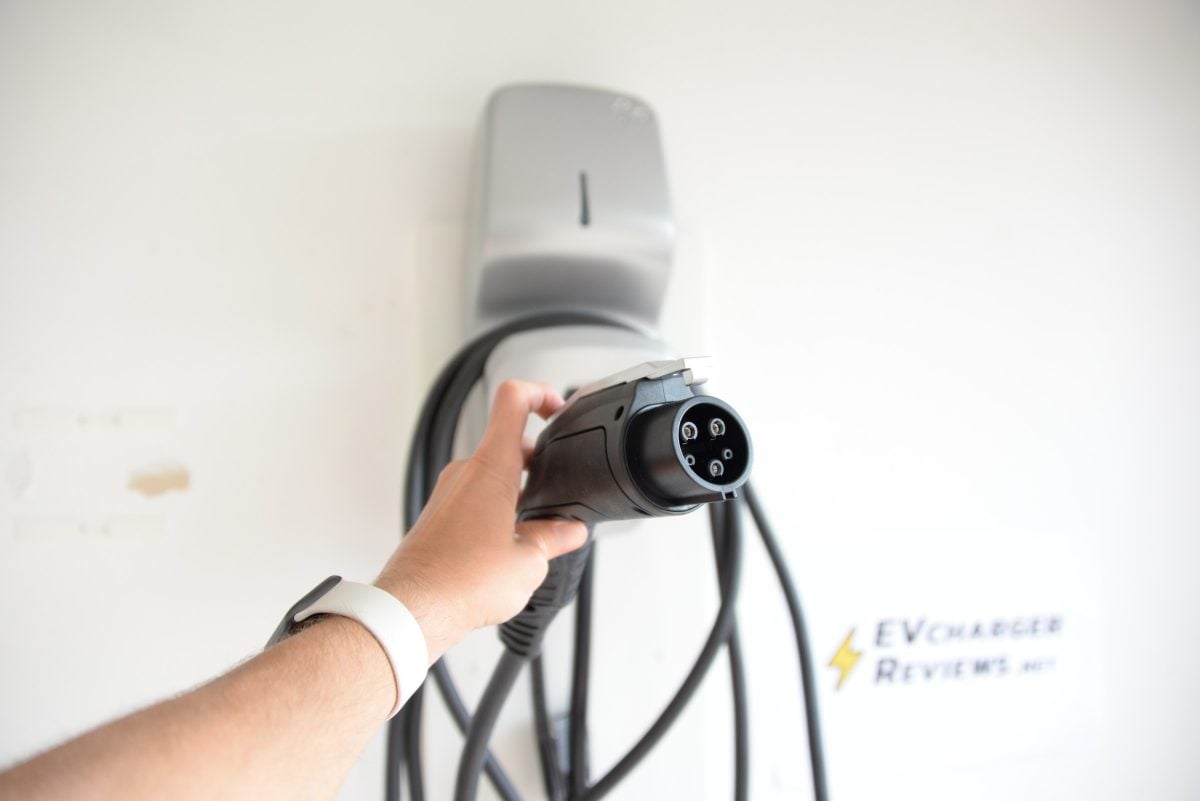EVchargerReviews is supported by our readers. We may earn commissions from links on this page. Why trust us?
Best Level 2 Home EV Chargers Tested (2024)
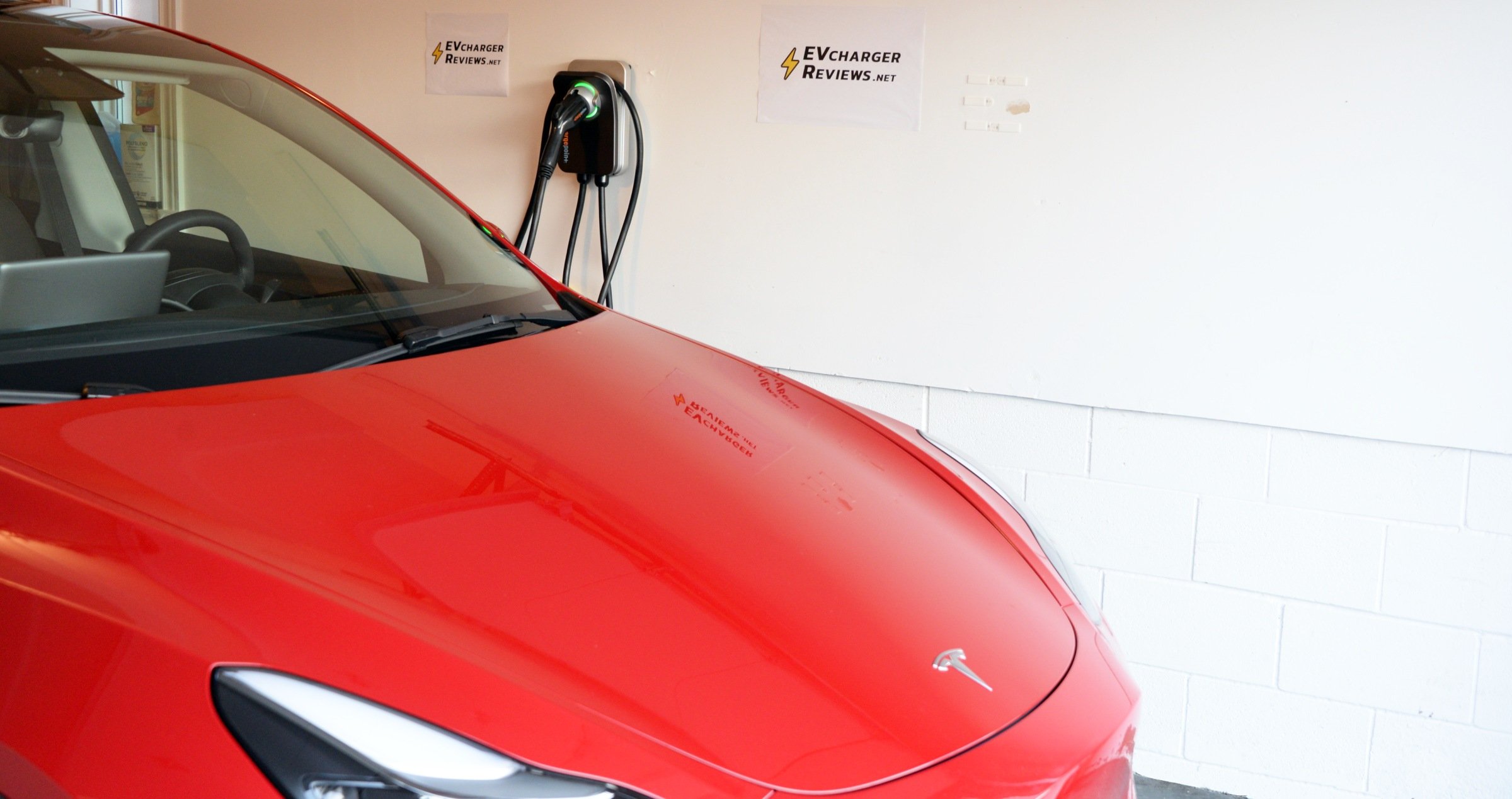
Updated December 29, 2024, by Michael Kim
Your new electric car is on the way, or maybe it is already here! You should consider installing a Level 2 charging station for your home because it is the most convenient and fastest way to charge your EV at home. A 240-volt Level 2 EV charger will charge four to eight times faster than a 120-volt “Level 1” outlet.
After two years of standardized testing with two EVs and 17 (and counting) of the most popular home charging products, seven products made the cut below. You can’t go wrong with any of these charging stations, but we’ve highlighted their differentiating features.
Why trust us? We have hands-on testing experience with the most popular EV charging products. Check our work here.
Top Level 2 EV Chargers We Tested
- Best Right Now: Tesla Wall Connector
- Best App: EVIQO Level 2 EV Charger
- Premium Pick: Chargepoint Home Flex
- Simple and Durable: LENZ EV Charger
- For Smart Homes: Leviton EV48W
- For Secure Access: Autel AC Lite
- Extreme Outdoor Conditions: FLO Home X5
Best Right Now: Tesla Universal Wall Connector
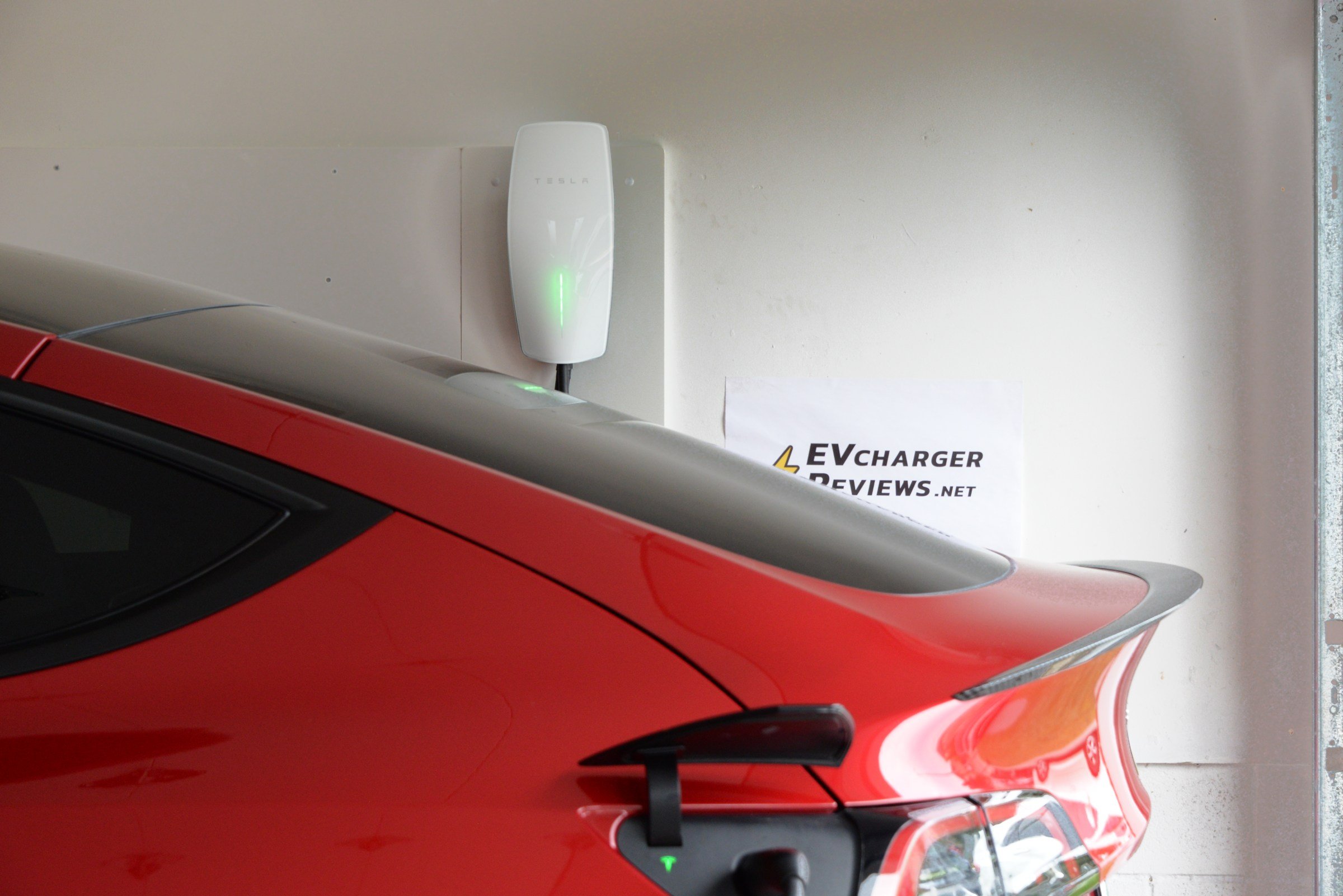
Check Prices:
The Tesla Wall Connector was already the best choice for most Tesla drivers. Now there is a new Universal Wall Connector that works with J1772 plugs too. Regardless of your EV brand preferences, this charging station is a smart choice for the long term as the Tesla (NACS) connector will become the de facto standard in North America in 2025.
We like the integrated cord management features of this product, and the cord is easy to handle in any climate but robust enough to handle 48 amps without overheating.
Specs
- Amperage: Up to 48 amps
- EV Connector: NACS, J1772
- Home Connection: Hardwire only
- Cord Length: 24 feet
- Weatherproofing:
NEMA 3R - Networking: Wi-Fi
- App Control: Yes
Pros
- Integrated cord holder
- Powerful 48 amp charging
- Ready for current and future EVs
- Can be paired with the Tesla app
Cons
- No outlet options, must be hardwired
- The cord can get stiff in colder climates
Best App: EVIQO Level 2 EV Charger
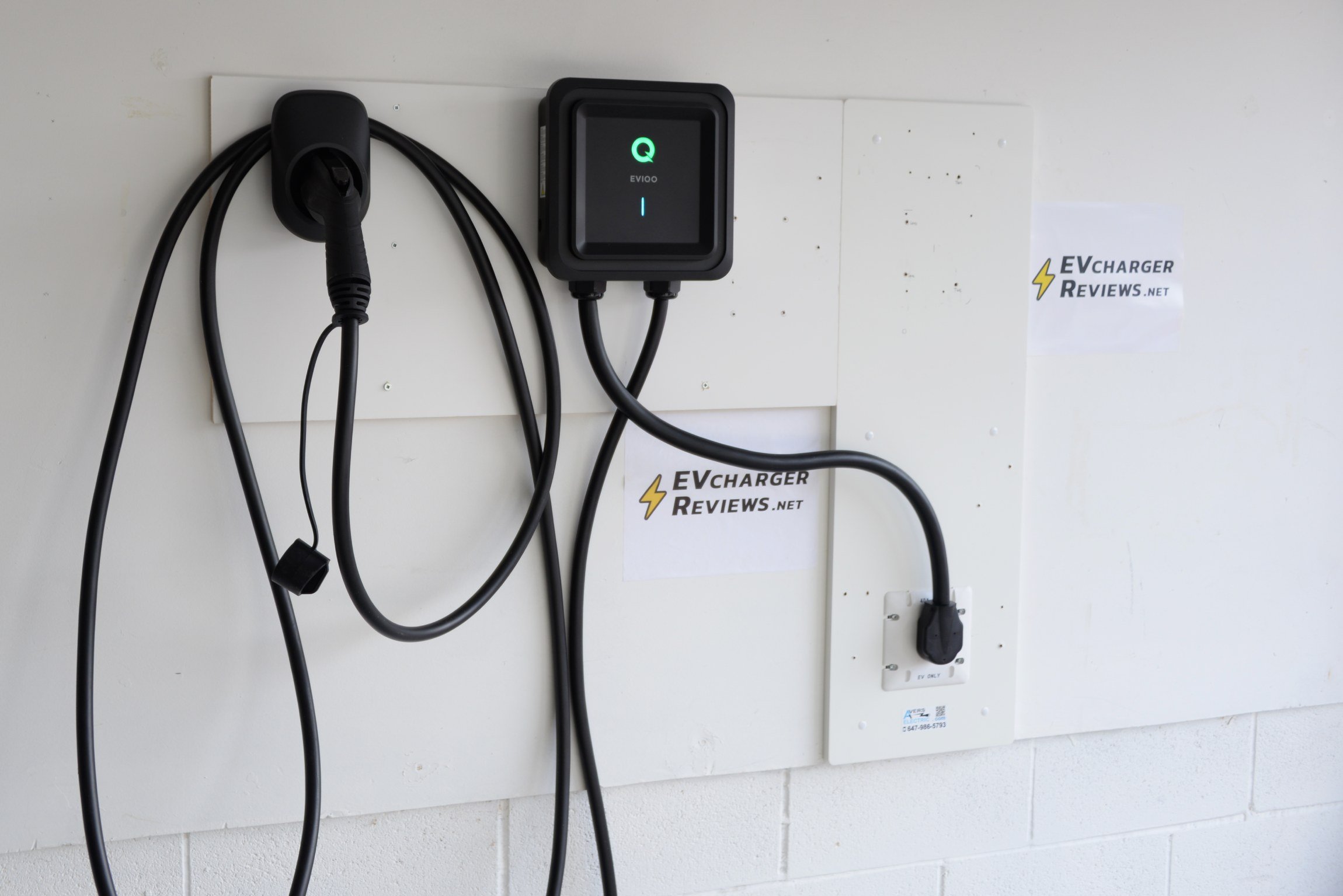
EVIQO surveyed 1,800 existing EV owners during their product development, and it is evident that many common charging complaints were addressed. The hardware is good all around, with quality components used in the cord and J1772 connector. Very generous cord lengths on both input and output.
The app and smart features are where EVIQO really shines. Both scheduling and electricity rates can be fine-tuned to fit most EV drivers’ specific situations, resulting in accurate and clear charging cost reports. Full review.
Specs
- Amperage: Up to 48 amps
- EV Connector: J1772
- Home Connection: NEMA 14-50 or hardwire
- Cord Length: 25 feet, 3-foot input cord
- Weatherproofing:
NEMA 4 - Networking: Wi-Fi + BT
- App Control: Yes
Pros
- Long input and output cables
- a smart app with scheduling and cost reports
- High-quality J1772 connector materials
Cons
- Cord quality is above average, but becomes rigid in cold weather
- The included holster makes the cord stick out from the wall
Premium Pick: Chargepoint Home Flex
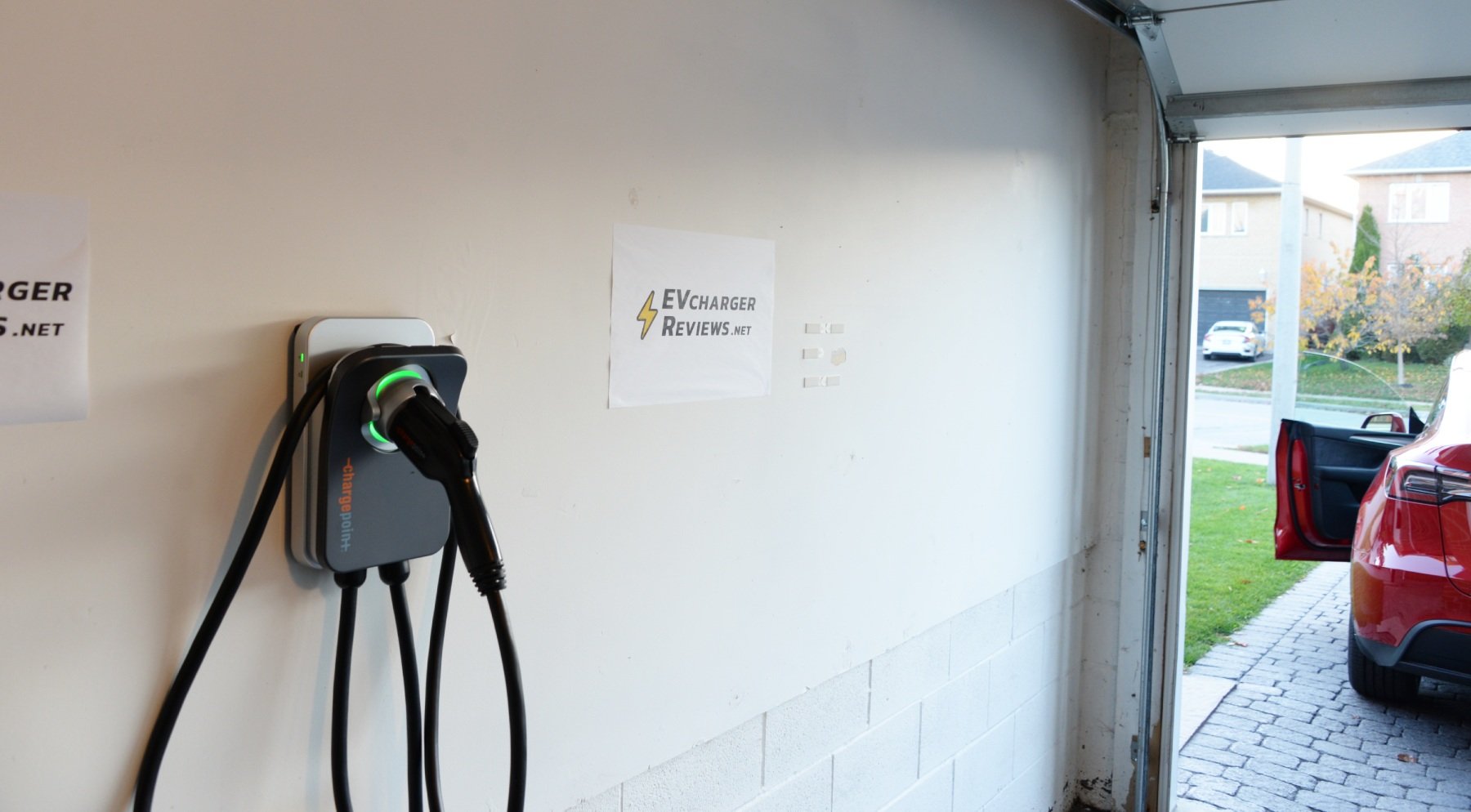
ChargePoint is a reputable brand in public charging as well as home charging. Priced at the higher end of the spectrum, the Home Flex is well-built, includes smart cable management, and a fully featured app. We were impressed when the app detected our utility provider by ZIP code, and automatically calculated accurate charging costs using up-to-date TOU electricity rates.
Compatible with all EVs on the market, the ChargePoint Home Flex is our top choice for EVs with large-capacity batteries. The ChargePoint Home Flex is a top seller on Amazon and for good reason. As of March 2024, ChargePoint offers a version with a native NACS connector too. Full review.
Specs
- Amperage: Up to 50 amps
- EV Connector: J1772 or NACS
- Home Connection: NEMA 14-50, 6-50, or hardwired
- Cord Length: 23 feet
- Weatherproofing:
NEMA 3R - Networking: Wi-Fi + BT
- App Control: Yes
Pros
- Energy Star Certified
- Wi-Fi connectivity
- Cord remains pliable in colder temperatures
- Up to 50 amps
Cons
- The ChargePoint mobile app and account are required for setup
- Only one Home Flex can be paired to an account
Simple and Durable: LENZ Level 2 EV Charger
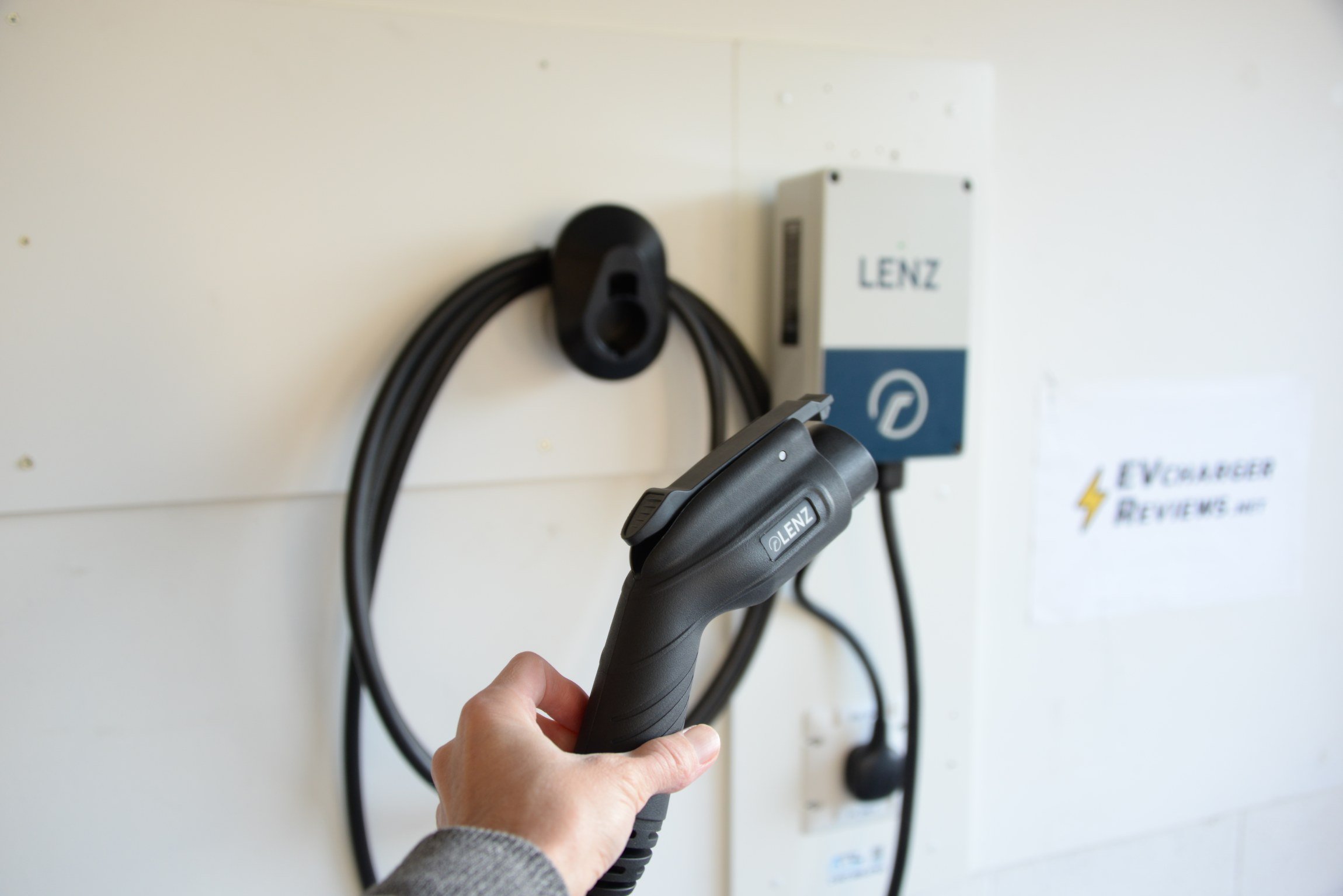
Need something solid but without the bells and whistles? LENZ has a great value Level 2 charging station with a robust metal enclosure. The LENZ product can be installed (quickly and easily) inside or outside.
While it may not have connectivity options, most modern EVs will have built-in scheduling options. If you’re looking for something uncomplicated with a NEMA 14-50 wall plug, LENZ is a great choice.
We were impressed with the quality of the materials of the enclosure, the cable, and the J1772 connector. This charging station also managed to stay very cool while operating at 40 amps. But the cord holster could be improved for cable management. Full review.
Specs
- Amperage: Up to 40 amps
- EV Connector: J1772
- Home Connection: NEMA 14-50 or hardwire
- Cord Length: 24 feet
- Weatherproofing:
NEMA 4X - Networking: No
- App Control: No
Pros
- Great value for a basic home charging station
- Durable enclosure materials
- Good quality charging cable
Cons
- Holster design could be better
- The status indicator is just a small LED light
For Smart Homes: Leviton EV48W
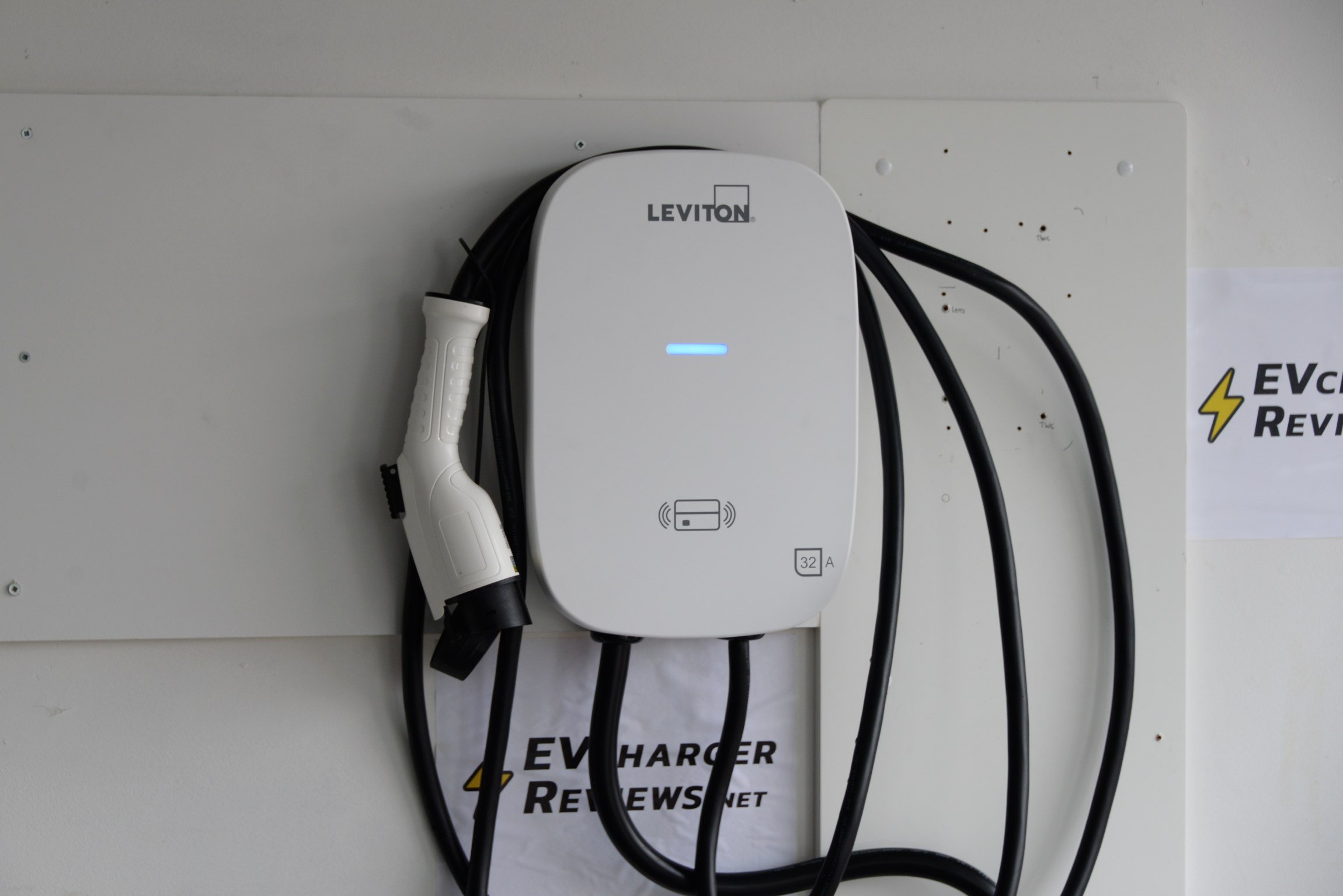
Leviton is a brand with a long history in home electrical products, and their EV charging products demonstrate their commitment to safety. The EV48W is UL-listed and EnergyStar-certified, and comes with a high-quality charging cord and a durable J1772 connector. Our only complaint is that at 18 feet, the cord could be a little bit longer.
Leviton’s smart switches and connected devices are popular among homeowners looking for smart home automation. Their latest EV charging stations are integrated into the same ecosystem and My Leviton app. This is a great option for drivers who already own other Leviton-connected products. Full review.
Specs
- Amperage: Up to 48 amps
- EV Connector: J1772
- Home Connection: Hardwire
- Cord Length: 18 feet
- Weatherproofing:
NEMA 3R - Networking: Wi-Fi + BT
- App Control: Yes
Pros
- Wi-Fi connectivity
- Works well with Leviton’s home automation app
- RFID security access cards
Cons
- Cord shorter than competing products
- Must be hardwired, no NEMA 14-50 plug-in option
For Secure Access: Autel AC Lite
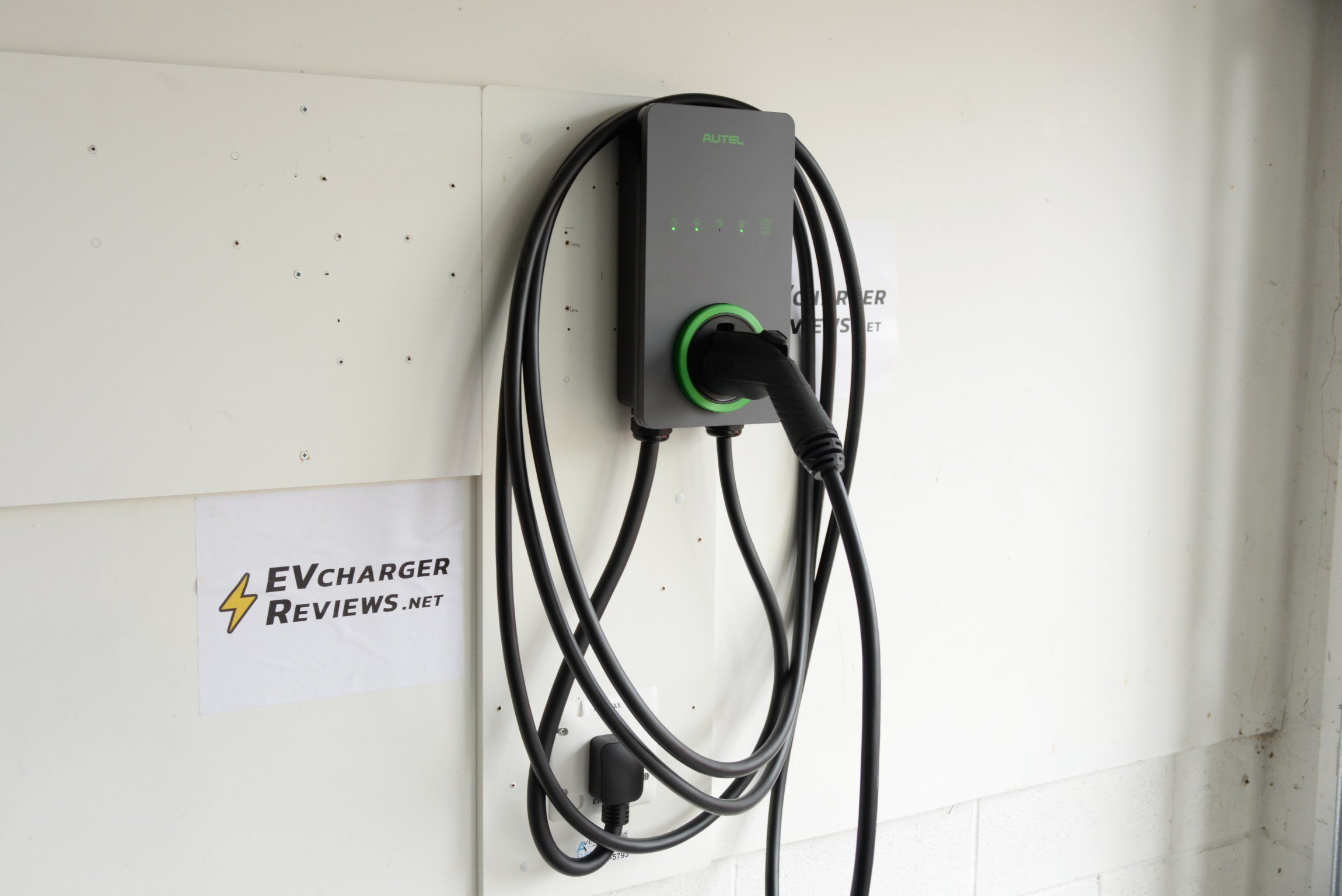
Autel has a growing product line of home EV chargers, and the latest Autel AC Lite is a great balance between price and features. Not only are the core specifications competitive for this segment, but the RFID card reader can be paired with almost any RFID card you already own. We were able to pair our charger with the Tesla keycard as well as a transit card.
For drivers looking for a secure access EV charging station, the Autel is a great pick. For example; outdoor or underground parking installation, where you want to prevent strangers from stealing your electricity.
Autel offers this product in two main versions, a 40-amp plug-in SKU, and a 50-amp hardwired version.
Specs
- Amperage: Up to 50 Amps
- EV Connector: J1772
- Home Connection: NEMA 14-50 or hardwire
- Cord Length: 25 feet
- Weatherproofing:
NEMA 4 - Networking: Wi-Fi + BT
- App Control: Yes
- RFID card reader for security
Pros
- Wi-Fi and Bluetooth connectivity
- Intuitive app
- Longer input cable than rivals, 32 inches
- RFID card reader for locking charger
- 3-year warranty
Cons
- The charging cord could be more flexible in freezing temperatures
- We saw some reporting delays in the app over Wi-Fi
For Extreme Outdoor Conditions: FLO Home X5

Québec-based FLO is best known for its North America-wide public charging network. Their latest home charging station, the Home X5, feels as durable as their outdoor public charging stations. The enclosure is made of molded aluminum both front and back, and the integrated holster and cable management systems are thoughtfully designed. The cable and connector are among the best we have ever tested; it is durable and freely coils around the charging station regardless of ambient temperature.
The Home X5 is an internet-connected smart home charging station, but a key difference is how the unit connects online. Instead of WiFi or Bluetooth, the FLO has built-in powerline networking (PLC). Some competing products struggle to maintain a Wi-Fi connection in our testing garage, but the FLO unit had zero connection issues with powerline networking. Full review.
Specs
- Amperage: Up to 30 amps
- EV Connector: J1772
- Home Connection: Hardwire
- Cord Length: 25 feet
- Weatherproofing:
NEMA 4X - Networking: Powerline
- App Control: Yes
Pros
- As durable as commercial chargers
- Reliable powerline networking
- Highly pliable cable
- 5-year warranty
Cons
- 30 amp output extends charging sessions
- The FLO app does not report on home charging costs
Didn’t find something you like? See all the products we tried here.
Methodology
Our testing facility is a residential two-car garage with a NEMA 14-50 receptacle installed by a licensed electrician. This setup will be similar to how most EV owners charge at home, and allow us to quickly and easily swap chargers for testing.
All products we recommend must be tested in our garage for at least two weeks and several EV battery charge cycles. A Tesla Model Y is our main test vehicle, but we have also borrowed an Ioniq 5 or VW ID.4 for some tests. While we consider user testimonials as part of the rating, the conclusions and recommendations are based on our own hands-on testing and experience with 16+ EVSE products reviewed. We are more familiar than anyone with common issues, shortcomings, and software bugs that appear in this product category, and we aim to surface the most polished products in front of our audience.
Our main criteria for products are (1) ease of use and installation, (2) power output, (3) cord length and management, (4) design and materials used, (5) smart features, and (6) reliability/warranty. Not every product we test is good enough to recommend. This article will be kept up to date with our favorite home EV charging stations as more products are released and tested by our team. You can see our full review feed here.

What is a Home EV Charger?
Home EV Chargers are devices (usually wall-mounted) that safely connect your electric car to your household’s electric circuit. Technically speaking, the wall-mounted device commonly referred to as an “EV Charger” is called an Electric Vehicle Service Equipment (EVSE), and it passes electricity to the onboard vehicle charger. The onboard charger is the actual equipment that converts household alternating current (AC) to direct current (DC) required to charge the battery. But for the sake of simplicity and understanding, most people call the wall-mounted EVSEs as home EV Chargers.
Self Install vs. Hiring an Electrical Contractor
Is an EV charger installation something you can do yourself? Sometimes. Many newer homes are pre-wired and have a 240-volt plug near where your car is parked. NEMA 14-50 and NEMA 6-50 are common 50-amp wall receptacles that a home charging station can plug into. If you already have an outlet installed, you may buy and install the equipment by yourself safely.
If you don’t already have a 240-volt receptacle on your wall, or if you are planning to hardwire your charging station (to go above 40 amps), then working with a licensed electrician is highly recommended. An electrical contractor will be able to assess the existing capacity of your electrical panel, run the appropriate gauge insulated wiring to your garage, as well as help receive any permits required in your local area.
How Much Does it Cost to Install a Home EV Charger?
If you already have a 240-volt outlet, no electrical work is required for a plug-in style home charging station. A general contractor or DIY homeowner can do it in about an hour of work.
If you do not have an outlet, but your household electrical panel has the capacity for a dedicated 40, 50, or 60-amp line, a qualified and licensed electrician will need to run wiring from the breaker box to your charging location. Some regions will require an additional permit for electrical work and upgrades. Expect to pay a few hundred dollars, with costs increasing proportionally with distance from the electrical panel. Our more complicated NEMA 14-50 installation was around $1,200 for a 50+ foot run and electrical permit.
If your home’s electrical supply cannot support a dedicated 30+ amp 240-volt line, like some older construction homes, then major electrical upgrades could cost thousands of dollars to support Level 2 EV charging. A licensed electrician may be able to develop a lower (slower) power solution that still charges an EV at 16, 20, or 24 amps.
Can You Install an EV Charger on the Outside of Your Home?
Absolutely. EV charging stations can be mounted to an exterior wall or a pedestal near your parking location. For outdoor installations, due to potential exposure to moisture and precipitation, it is recommended to have the unit hardwired to the electrical circuit rather than using a 240v outlet like the NEMA 14-50.
It’s important to pay attention to weather resistance ratings when shopping for an outdoor EV charging station. Most EV charger enclosures on the market are rated at least IP66, which protects the equipment from raindrops and water jets. For outdoor usage, we recommend tougher products that have NEMA water resistance ratings. For example; NEMA Type 4 and Type 3R products like the Tesla Wall Connector are intended for outdoor use and will withstand rain, snow, and ice formation. For extreme climates, NEMA Type 4X products like the Lenz EV Charger or FLO X5 have additional protection from corrosion which may develop from frequent exposure to moisture.
Remember that even the highest-rated enclosures should be installed high enough off the ground so they are never submerged in flood water.
Volts, Amps, & Kilowatts? What Do You Need to Know?
The basics of EV charging come down to line voltage (volts) and electric current measured in amperes (amps). You can think of voltage as “pressure” that pushes electricity. Amps describe the rate of electric current flow, the rate of electrons flowing through a wire. When you multiply the volts and amps together, you can calculate the total power of the system in Watts.
You’re likely familiar that standard electrical wall outlets in North America operate at 120 volts. You could find a Level 1 charging adapter that can use a 120-volt outlet and carry 12 amps of current. That means 1,440 Watts (120*12) of power is delivered to the EV, or 1.4 kilowatts.
Most Level 2 EV charging at home (and in public) is connected to 208-240 volt lines that are able to carry more current. For example, a home charging station operating on 240 volts that can carry 48 amps delivers a total of 11,520 Watts or 11.5 kW of power. That’s eight times more power than a standard 120-volt outlet.
Watts are a measure of power, but watt-hours are a measure of energy delivered. Charging an EV at 11.5 kW for 5 hours means that 57.5 kilowatt-hours (kWh) of energy is consumed. You can also estimate that an EV with a 75 kWh battery capacity could take about 6.5 hours to fully charge at 11.5 kW.
Hardwire Installation vs. 240V Outlet Installation
Many home EV charger products on the market offer the ability to plug into NEMA 14-50 outlets or be hardwired directly to the circuit by a licensed electrician. The choice depends on your specific needs and circumstances.
The benefit of hardwiring a charging station is that there are fewer points of failure for a long-term installation, it is generally safer, and it allows you to charge at higher than 40 amps (9.6 kW). However, hardwire installation (and moving) must be done to code and spec by a licensed professional. The right materials and screw torque must be used to avoid heat and component meltdown. We recommend a hardwired installation for most homeowners.
Alternatively, connecting an EV charger to a 240-volt NEMA 14-50 or NEMA 6-50 outlet is quick and easy to install or remove. Mind you, if you don’t already have an outlet, one must also be professionally installed. Outlet-connected EV chargers are great options for renters and for users of portable charging units. The downside is that the output is limited to 40 amps. You must also keep an eye out for signs of wear and tear on the outlet and plug if removed frequently.
What is the Fastest Level 2 EV Charger?
In North America, Level 2 EV charging stations for your home or business will range in output between 30 and 50 amps. Most electric cars on the market can charge between 32 and 48 amps.
Assuming your EV can charge at 48 amps (11 kW), you can take full advantage of this charging speed by looking at home charging stations that support 48 amps. Products such as the Tesla Wall Connector, ChargePoint Home Flex, Emporia EV Charger, or Wallbox Pulsar Plus can charge at 48 amps. Keep in mind that any home charging station that outputs more than 40 amps will need to be hardwired by a licensed electrician because plugs like the NEMA 14-50 are limited to 50 amps constant load.
Do you actually need the absolute fastest charger? Charging speed becomes less important if most of your charging is done overnight. Even a 30 amp charging station from FLO can deliver 7 kW (30 amps * 240 volts), which means 84 kWh of energy can be delivered in 12 hours. More than enough for most EVs. Charging gradually at a slow speed overnight will also benefit your local electrical grid by distributing the load.
Do You Need a “Smart” EV Charger or a Basic One?
A regular non-smart EV charging station contains electronics to safely connect and carry energy from the wall to the electric car. The electronics only need to initiate a charging session and monitor temperatures, voltage, current, etc. These basic EV chargers begin working immediately upon plugging into a car and are perfect for EV owners looking for an uncomplicated experience. Most modern EVs have built-in charge scheduling functionality that can work with any home EV charging station.
Smart home EV charging stations have networking capabilities using Wi-Fi, Ethernet, or even powerline networking. Smart chargers usually have a companion mobile app or web interface for management. An Internet-connected home EV charging station can offer some or all of these benefits:
- Monitor real-time charging sessions
- Change current amp output limits
- Lock or limit charging access to specific cars
- Some EV chargers offer very granular scheduling options throughout the week
- Notifications can be sent to the user’s phone if they forgot to plug in their EV
- Many smart EV chargers offer energy consumption reporting
- Connected chargers may be able to communicate with a participating electric utility using the Open Charge Point Protocol (OCPP) for demand response. For example; if a local grid is overloaded, the utility could send a signal to throttle your EV charging speed.
What is the difference between Level 1, Level 2, and Level 3 charging?
The difference lies in voltage, amperage, and ultimately the charging speed.
Level 1 charging is done over standard household electrical outlets. In North America that means 120 volts and 12 amps. This translates into about 1.4 kW of power and around 3 miles of range added per hour. Although 120-volt outlets are abundant, they will not provide enough range overnight for most drivers.
Level 2 charging steps up the voltage to ~240 volts and current can go as high as 80 amps, but most EVs max out at 48 amps. Charging at 7-11 kW on Level 2 will recharge most EVs in only a few hours. Level 2 charging makes EV driving convenient and cost-effective, but will have some upfront installation costs.
Level 3 charging boosts the voltage to 400/800 volts and can routinely pull 500+ amps. An EV can get the majority of the driving range back in a matter of minutes on Level 3 charging. This is possible by bypassing the onboard vehicle alternating current (AC) charging equipment and sending direct current (DC) straight to the battery. Due to the immense power requirements of Level 3, it is only feasible for commercial applications and not at-home EV charging.
Are Rebates or Incentives Available For Home EV Chargers?
Many states have incentive programs to reduce the cost of the transition to electric driving. You may be eligible to be reimbursed for a portion of the cost of the EV charger and/or professional installation. Incentive structures change on a regular basis, we track incentives on this page.
Change log
- December 29, 2024: Product info and video updates.
- March 14, 2024: Product information updates and article restructure.
- March 9, 2024: Included more shopping options for readers. Clearing up details on test methodology.
- March 3, 2024: Updated product picks based on recent reviews. Included more details on the methodology and hardwire vs. outlets.
- February 23, 2024: Updated product information. Added commentary about outdoor installations.
- January 29, 2024: Revised product recommendations based on recent user experience and product availability.
- December 18, 2023: Revised product recommendations based on the latest testing. Updated explanation on fastest charging stations.
- November 20, 2023: Included information about the distinction between smart networked EV chargers and “dumb” chargers. Added current sales promos.
- September 18, 2023: Revised product selection based on newest product tests. Included more details about the methodology.

